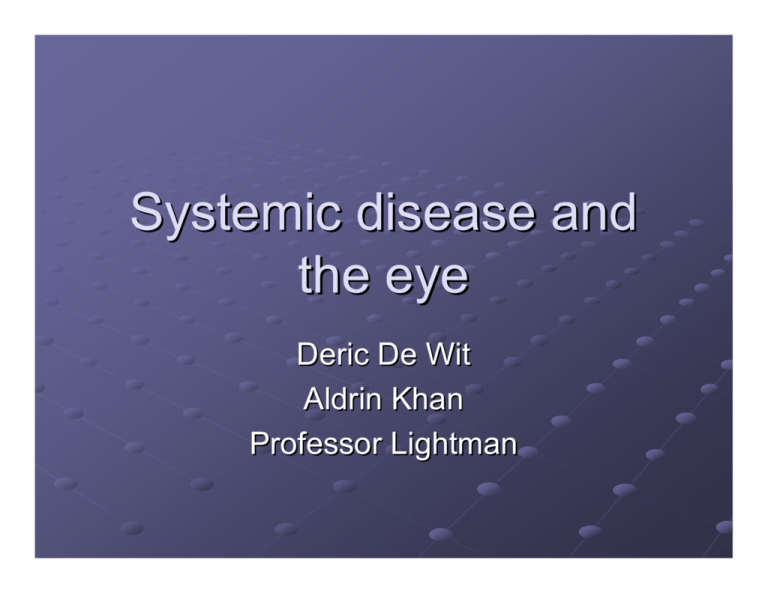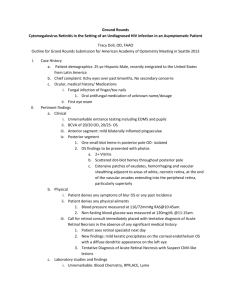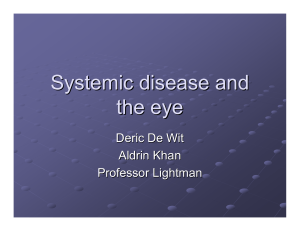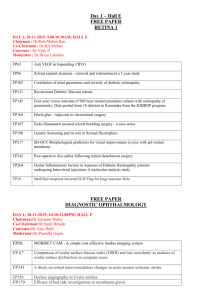Systemic disease and the eye
advertisement

Systemic disease and the eye Deric De Wit Aldrin Khan Professor Lightman Common systemic diseases affecting the eye Infectious Toxoplasmosis Toxocariasis TB Syphilis Leprosy HIV CMV Non-infectious Endocrine – diabetes, thyroid Connective tissue disease – RA/SLE/Wegeners/PAN/ Systemic sclerosis Vasculitides (GCA) Sarcoidosis Behcet’s Disease Vogt Koyanagi Harada syndrome Phakomatoses DIABETIC RETINOPATHY 1. 2. 3. 4. Adverse risk factors Pathogenesis Background diabetic retinopathy Diabetic maculopathies • Focal • Diffuse • Ischaemic 5. Clinically significant macular oedema 6. Preproliferative diabetic retinopathy 7. Proliferative diabetic retinopathy Adverse Risk Factors 1. Long duration of diabetes 2. Poor metabolic control 3. Pregnancy 4. Hypertension 5. Renal disease 6. Other • • • • Obesity Hyperlipidaemia Smoking Anaemia Location of lesions in background diabetic retinopathy Signs of background diabetic retinopathy Microaneurysms usually temporal to fovea Hard exudates frequently arranged in clumps or rings Intraretinal dot and blot haemorrhages Retinal oedema seen as thickening on biomicroscopy Preproliferative diabetic retinopathy Signs • Cotton-wool spots • Venous irregularities • Dark blot haemorrhages • Intraretinal microvascular abnormalities (IRMA) Treatment - not required but watch for proliferative disease Proliferative diabetic retinopathy • • Affects 5-10% of diabetics IDD at increased risk (60% after 30 years) Neovascularization • • Flat or elevated Severity determined by comparing with area of disc Neovascularization of disc = NVDNeovascularization elsewhere = NVE Laser panretinal photocoagulation • • • Initial treatment is 2000-3000 burns• Area covered by complete PRP Spot size (200-500 µm) depends on contact lens magnification • Gentle intensity burn (0.10-0.05 sec) Follow-up 4 to 8 weeks Retinal Vein Occlusion Second most common cause of vascular-related visual loss. Risk factors: hypertension, age, blood dyscrasias (OCP,HRT) and vasculitis (Behcets,sarcoidosis,AIDS,SLE) Retinal Artery Occlusion Risk factors: Carotid artery atherosclerosis (CRAO), carotid emboli (BRAO), vasculitis (GCA,SLE,PAN), coagulopathy. OCULAR EMERGENCY - Immediate referral to ophthalmologist THYROID EYE DISEASE 1. Soft tissue involvement • • • • Periorbital and lid swelling Conjunctival hyperaemia Chemosis Superior limbic keratoconjunctivitis 2. Eyelid retraction 3. Proptosis 4. Optic neuropathy 5. Restrictive myopathy Soft tissue involvement Periorbital and lid swelling Chemosis Conjunctival hyperaemia Superior limbic keratoconjunctivitis Signs of eyelid retraction Occurs in about 50% • Bilateral lid retraction • No associated proptosis • Bilateral lid retraction • Bilateral proptosis • Unilateral lid retraction • Unilateral proptosis • Lid lag in downgaze Proptosis • Occurs in about 50% • Uninfluenced by treatment of hyperthyroidism Axial and permanent in about 70% May be associated with choroidal folds Treatment options • Systemic steroids • Radiotherapy • Surgical decompression Optic neuropathy • Occurs in about 5% • Early defective colour vision • Usually normal disc appearance Caused by optic nerve compression at orbital apex by enlarged recti Often occurs in absence of significant proptosis Restrictive myopathy • Occurs in about 40% • Due to fibrotic contracture Elevation defect - most common Abduction defect - less common Depression defect - uncommon Adduction defect - rare SARCOIDOSIS Idiopathic multisystem disorder Characterised by non-caseating granulomata More common in women 20-50 yrs More common in blacks and Asians ? Related to mycobacteria SARCOIDOSIS Systemic Involvement Lung lesions – 95% Thoracic lymph nodes – 50% Skin lesions – 30% → Eyes – 30% SARCOIDOSIS Ocular Involvement Anterior segment lesions (30%) Conjunctival granuloma Lacrimal gland involvement/dry eye Acute or chronic uveitis → KPs described as ‘mutton fat’ because they are large and greasy SARCOIDOSIS Ocular Involvement Posterior segment lesions (20%) Patchy venous sheathing Cellular infiltrate around vessels Chorioretinal granulonmas Vasculitis including occlusive causing:Neovascularisation Infiltrate in vitreous (vitritis) including cell clumps (snowballs) SARCOIDOSIS Ocular Involvement Sheathing of the retinal veins Fluorescein angiography showing leakage and staining at sites of sheathing SARCOIDOSIS Granuloma in Fundus Retinal and preretinal Choroidal SARCOIDOSIS Granuloma in Fundus Optic nerve head granuloma Normal optic nerve head SARCOIDOSIS Systemic Signs Lupus pernio affecting the nose – a chronic progressive cutaneous sarcoid that most commonly affects face and ears SARCOIDOSIS Systemic signs Facial palsy Salivary gland enlargement SARCOIDOSIS Systemic signs Hilar adenopathy on chest x-ray Lung infiltrate Erythema nodosum Arthritis SARCOIDOSIS Investigations (1) CXR – to detect pulmonary signs Bilateral hilar lymphadenopathy Pulmonary mottling SARCOIDOSIS Investigations (2) Serum angiotensin-converting enzyme (ACE) – elevated in active sarcoidosis Mantoux test – caution in patients who have had BCG vaccination. Test may be negative Lung function tests SARCOIDOSIS Investigations (3) Gallium scan showing increased uptake in the lacrimal and parotid glands and pulmonary regions in a patient with active sarcoidosis SARCOIDOSIS Treatment Systemic steroids may be necessary in patients with posterior segment disease where vision is threatened, especially if optic nerve is involved PHACOMATOSES 1. Neurofibromatosis • Type I (NF-1) - von Recklinghausen disease • Type II (NF-2) - bilateral acoustic neuromas 2. Tuberous sclerosis (Bourneville disease) 3. von-Hippel-Lindau syndrome 4. Sturge-Weber syndrome Neurofibromatosis type-1 - (NF-1) • • • • Most common phacomatosis Affects 1:4000 individuals Presents in childhood Gene localized to chromosome 17q11 Café-au-lait spots Appear during first year of life Increase in size and number throughout childhood Fibroma molluscum in NF-1 Appear at puberty • Pedunculated, flabby nodules consisting of neurofibromas or schwannomas • Increase in number throughout life • Frequently widely distributed • Plexiform neurofibroma in NF-1 • • Appear during childhood Large and ill-defined • May be associated with overgrowth of overlying skin Skeletal defects in NF-1 • Facial hemiatrophy • • Mild head enlargement - uncommon Other - scoliosis, short stature, thinning of long bones Orbital lesions in NF-1 Optic nerve glioma in about 15% Spheno-orbital encephalocele • Axial CT scan of congenital absence of • Sagittal MRI scan of optic nerve glioma left greater wing of sphenoid bone invading hypothalamus • Glioma may be unilateral or bilateral• Causes pulsating proptosis without bruit Eyelid neurofibromas in NF-1 Nodular May cause mechanical ptosis Plexiform May be associated with glaucoma Intraocular lesions in NF-1 Lisch nodules Congenital ectropion uveae Very common - eventually present Uncommon - may be associated in 95% of cases with glaucoma Choroidal naevi Retinal astrocytomas Common - may be multifocal Rare - identical to those seen in tuberous sclerosis and bilateral Ocular features of NF-2 Very common p- resenile cataract Common - combined hamartomas of RPE and retina Tuberous sclerosis (Bourneville disease) • • Autosomal dominant Triad - mental handicap, epilepsy, adenoma sebaceum Adenoma sebaceum • • Around nose and cheeks Appear after age 1 and slowly enlarge Ash leaf spots • • Hypopigmented skin patches In infants best detected using ultraviolet light (Wood’s lamp) Shagreen patches • • Diffuse thickening over lumbar region Present in 40% Systemic hamartomas in tuberous sclerosis Astrocytic cerebral hamartomas Visceral and subungual hamartomas • Slow-growing periventricular tumours • Usually asymptomatic and • May cause hydrocephalus, epilepsy and innocuous • Kidneys (angiomyolipoma), heart mental retardation (rhabdomyoma) Retinal astrocytomas in tuberous scleritis • • Innocuous tumour present in 50% of patients May be multiple and bilateral Early Semitranslucent nodule White plaque Advanced Dense white tumour Mulberry-like tumour Systemic features of v-H-L syndrome Autosomal dominant CNS Haemangioblastoma Visceral tumours MRI of spinal cord tumour • Tumours - renal carcinoma and phaeochromocytoma • Cysts - kidneys, liver, pancreas, epididymis, ovary and lungs Angiogram of cerebellar• Polycythaemia tumour Retinal capillary haemangioma in v-H-L syndrome • • Vision-threatening tumour present in 50% of patients May be multiple and bilateral Early Tiny lesion between Small red nodule arteriole and venuole Advanced dilatation and Round orange-red massAssociated tortuosity of feeder vessels Systemic features of Sturge-Weber syndrome Naevus flammeus • • Congenital, does not blanche• with pressure Associated with ipsilateral • glaucoma in 30% of cases Meningeal haemangioma CT scan showing left parietal haemangioma Complications - mental handicap, epilepsy and hemiparesis Ocular features of Sturge-Weber syndrome Glaucoma Buphthalmos in 60% May be associated with episcleral haemangioma Diffuse choroidal haemangioma Normal eye Affected eye Peripheral corneal involvement in rheumatoid arthritis Without inflammation With inflammation • Chronic and asymptomatic • Acute and painful • Circumferential thinning with intact • Circumferential ulceration and epithelium (‘contact lens cornea’) infiltration Treatment - systemic steroids and/or cytotoxic drugs Peripheral corneal involvement in Wegener granulomatosis and polyarteritis nodos Circumferential and central ulceration similar to Mooren ulcer Unlike Mooren ulcer sclera may also become involved Treatment - systemic steroids and cyclophosphamide GIANT CELL ARTERITIS (Temporal or Cranial Arteritis) Idiopathic vasculitis Same disease spectrum as polymyalgia rheumatica Mainly women 65-80 years old Medium and large arteries in head & neck involved GIANT CELL ARTERITIS Presentation Headache Scalp tenderness Thickened temporal arteries Jaw claudication Acute visual loss Weight loss, anorexia, fever, night sweats, malaise & depression GIANT CELL ARTERITIS Ocular Complications Transient monocular visual loss (amaurosis fugax) Visual loss due to Central retinal artery occlusion (CRAO) or Anterior ischaemic optic neuropathy (AION) Visual field defects GIANT CELL ARTERITIS Management ESR if suspected Start high dose steroids immediately to prevent stroke or second eye involvement Temporal artery biopsy within a week of starting steroids GIANT CELL ARTERITIS Temporal Artery Biopsy Arteries have skip lesions ultrasound/Doppler may help identify involved areas If positive, confirms diagnosis – helpful in management of future disease If negative, doesn’t exclude diagnosis, but need to think about an alternative diagnosis GIANT CELL ARTERITIS Histopathology Granulomatous cell infiltration Giant cells Disruption of internal elastic lamina Proliferation of intima Occlusion of lumen GIANT CELL ARTERITIS Treatment Intravenous and oral steroids – prolonged course of steroids often necessary Ocular manifestations of HIV infection Introduction AIDS is an infectious disease caused by the gradual decrease in CD4+ T lymphocytes causing subsequent opportunistic infections and neoplasia. It is a blood borne and sexually transmitted infection caused by the HIV (Human Immunodeficiency Virus) Approximately 36 million persons around the world are infected. Up to 70% of patients infected with HIV will develop some form of ocular involvement, ie: direct infection by HIV,opportunistic infections and neoplasia. HIV infection progresses though different phases Ophthalmic Manifestations of HIV Infection AROUND THE EYE Molluscum Contagiosum Herpes Zoster Ophthalmicus Kaposi’s Sarcoma Conjunctival Squamous Cell Carcinoma Trichomegaly FRONT OF THE EYE Dry Eye Anterior Uveitis BACK OF THE EYE Retinal Microvasculopathy CMV Retinitis Acute Retinal Necrosis Progressive Outer Retinal Necrosis Toxoplasmosis Retinochoroiditis Syphilis Retinitis Candida albicans endophthalmitis NEURO-OPHTHALMIC Molluscum Contagiosum Molluscum contagiosum is a viral infection of the skin. Affects up to 20% of symptomatic HIV infected patients. Clinically appears like painless, small, umbilicated nodules, which produce a waxy discharge when pressured. Treatment consists on excision of the lesion, curettage or cryotherapy Herpes Zoster Ophthalmicus Due to the reactivation of a latent infection by Varicella Zoster Virus in the dorsal root of trigeminal nerve ganglion. It manifests with a maculo-papulo-vesicular rash which often is preceded by pain. Usually involves the upper lid and does not cross the midline Treatment consists on oral Aciclovir 800mg 5 times /day. In immunocompromised patients Aciclovir is given intravenously for two weeks. Ocular manifestations such as anterior uveitis, are treated with topical steroids and mydriatics. Kaposi’s Sarcoma Kaposi’s sarcoma is a vascular neoplasm which is almost exclusively seen in patients with AIDS. KS is the commonest anterior segment lesion seen in AIDS; appears as a violaceous non-tender nodule on the eyelid or conjunctiva. Typically KS involves only the skin but when there is a reduced CD4 count it can progress rapidly to other sites such as the gastrointestinal tract and CNS Treatment of ocular adnexal KS may be necessary for cosmesis and to relieve functional difficulties. The mainstay of treatment is radiotherapy. Other options include cryotherapy or chemotherapy. Conjunctival Squamous Cell Carcinoma Squamous cell carcinoma (SCC) is the third most common neoplasm associated to HIV infection. This may be due to an interaction between HIV, sunlight and Human Papilloma Virus infection. SCC appears as a pink, gelatinous growth, usually in the interpalpebral area. Often an engorged blood vessel feeding the tumour is seen. It may extend onto the cornea, but deep invasion and metastasis are rare. The treatment of choice is local excision and cryotherapy but the presence of orbital invasion is an indication of exenteration Trichomegaly Trichomegaly or hypertrichosis is an exaggerated growth of the eye lashes found in the later stages of the disease The cause is not known When symptomatic or for cosmetic reasons the eyelashes can be trimmed or plucked Dry Eye Sicca syndrome is frequent among patients with HIV infection Patients complain of burning uncomfortable red eyes. There are several causes of dry eye in HIV infection from blepharitis to destruction of the lacrimal glands. Treatment is with tear supplements Anterior Uveitis HIV related anterior uveitis can be: Direct manifestation of the human immunodeficiency virus infection autoimmnune in origin drug induced ie: rifabutin, secondary to direct toxic effect upon the nonpigmented epithelium of the ciliary body Any of the different infections associated with AIDS, ie: Herpes Zoster Virus, Herpes Simplex Virus, Rifabutin induced anterior uveitis Retinal microvasculitis Retinal microvasculopathy occurs in more than half of the patients with HIV It is seen as transient cotton wool spots (CWS), intra-retinal haemorrhages and microaneurysm, which occurs in 50-70% of patients. It is usually asymptomatic. It has an unclear pathogenesis, but it is thought to be HIV infection of retinal vascular cells. In an otherwise healthy individual the presence of CWS, should be differentiated from other forms of retinopathy, such as diabetic or hypertensive retinopathy. Serological test for HIV will confirm the diagnosis Treatment is based in delaying the progression of the disease associated with HIV Cotton Wool Spots CMV Retinitis Introduction CMV Retinitis is the commonest intraocular ocular opportunistic infection seen in patients with AIDS Antibodies are found in almost 95% of adults, causing a trivial illness in immunocompetent adults, however severe immunosuppression causes viral reactivation and tissue invasive disease Pathogenesis Reactivation from extraocular sites leads to seeding in other sites such as the retina Epidemiology The number of newly diagnosed cases of CMVR has decreased since the introduction of the HAART Highly HighlyActive ActiveAntiretroviral AntiretroviralTherapy Therapy CMV Retinitis Clinical manifestations Patients may complain of minor visual symptoms such as floaters, flashing lights or mild blurred vision, or be totally asymptomatic. It presents with a wide range of clinical appearances. From cotton wool spots which may look like HIV Retinopathy to confluent areas of full thickness retinal necrosis and vasculitis. CMVR can progress in a “brushfire” pattern from the active edge of an active lesion. The retinal vessels in an affected area show attenuation, becoming ghost vessels eventually. Treatment The treatment of CMVR in patients with AIDS requires the use of specific antiviral agents, ganciclovir, foscarnet or cidovir in conjunction with HAART. These treatments can be administered orally, intravenously or intravitreally. Systemic treatment has the advantage of treating infection elsewhere in the body as well as the other eye but has the disadvantages of systemic side effects. I i li l l h d i h i d hi i CMV Retinitis Acute Retinal Necrosis ARN is a confluent peripheral whitening of the retina with marked vitritis and blood vessel closure. Optic neuritis and retinal detachment are frequent complications. ARN is usually due to Varicella-Zoster infection, but it can also be caused by Herpes Simplex virus or Cytomegalovirus. Initially described in the immunocompetent, it has also been described in the immunosuppressed. The diagnosis is mainly clinical and is confirmed by PCR assays on vitreous samples. Patients are treated with high doses of intravenous aciclovir or famciclovir, combined with laser treatment to prevent retinal detachment. Acute Retinal Necrosis Progressive Outer Retinal Necrosis (Varicella-Zoster Retinitis) PORN is a devastating viral retinitis caused by Varicella-Zoster virus, without vitritis or retinal vasculitis. The retinitis can be located anywhere but it is common for the lesions to coalesce and spread posteriorly in a rapid fashion. The main symptom is rapid loss of vision.The retina shows typically a white lesion with no haemorrhages or exudates. Treatment is often unsatisfactory and usually requires combination of Ganciclovir and Aciclovir. The prognosis is very poor and retinal detachment is common. Resolution may leave a white plaque with the appearance of “cracked mud”. Toxoplasma Retinochoroiditis Toxoplasmosis retinochoroiditis is an uncommon infection of the eye in AIDS. Ocular toxoplasmosis in HIV positive patients is different in appearance from immunocompetent patients. Unlike in immunocompetent patients, HIV infected patients often have bilateral and multifocal disease associated with anterior uveitis and vitritis but unlike immunocompetent patients, in HIV infected patients often have with no pigmented scars adjacent to the areas of retinal necrosis. Toxoplasmosis in immunocompromised patients is not self-limiting as it is in imunocompetent patients. Toxoplasma Retinochoroiditis When testing patients for antibodies to toxoplasmosis both IgG and IgM levels may be raised, but in immunocompromised patients these tests may be negative. Treatment in immunocompromised patients consists in the association of sulphadiazine or clindamycin, pyrimethamine and folinic acid (triple therapy). Long term maintenance treatment may be needed in order to prevent relapses. Often associated with toxoplasma lesions in the Central Nervous System. MRI T1 showing an uniformly enhancing lesion in the midbrain One week later, the lesion showing ring enhancement Immunocompetent Immunocompromised Syphilis Retinitis There is a strong association between syphilis and HIV infection. It can manifest as a retinitis with dense vitritis, retinal vasculitis, serous retinal detachment or neuroretinitis, as well as other types of ocular involvement such as, conjunctivitis, anterior uveitis, cranial nerve palsies and optic neuritis. Treatment consists in high dose of intravenous Penicillin for 2 weeks. Candida albicans endophthalmitis Infection with candida albicans is rare. Candida albicans is the commonest cause of fungal endophthalmitis Affected patients usually have a history of drug abuse or indwelling central lines In the initial stages, floaters are the main symptom. As the condition progresses, whitish “puff-balls” and vitreous strands develop. Later, similar infiltrates appear in the choroid and retina The treatment depends on the severity of the ocular involvement and systemic disease. The original foci should be removed. The drugs of choice are Amphotericine B and Fluconazol Candida albicans endophthalmitis Glossary CD4: Director of the immune response. When activated it releases cytokines which in turn will activate the immune system Cotton Wool Spots: Light-coloured deposits in the retina secondary to infarcts of the nerve fibre layer HAART: Highly Active Antiretroviral Therapy Immunoblogulin: Protein in charge of fighting foreign substances in our body. IgG is the commonest type of immunoglobulin and IgM is the earliest class of immunoglobulin. PCR: Polymerase Chain Reaction is a technique used to make numerous copies of an specific portion of DNA VDRL: Venereal Disease Research Laboratory. The test becomes negative after successful treatment of the disease.






